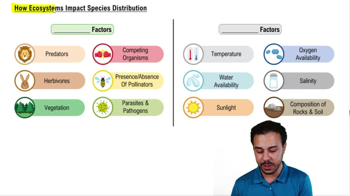Table of contents
- 1. Introduction to Biology2h 42m
- 2. Chemistry3h 40m
- 3. Water1h 26m
- 4. Biomolecules2h 23m
- 5. Cell Components2h 26m
- 6. The Membrane2h 31m
- 7. Energy and Metabolism2h 0m
- 8. Respiration2h 40m
- 9. Photosynthesis2h 49m
- 10. Cell Signaling59m
- 11. Cell Division2h 47m
- 12. Meiosis2h 0m
- 13. Mendelian Genetics4h 44m
- Introduction to Mendel's Experiments7m
- Genotype vs. Phenotype17m
- Punnett Squares13m
- Mendel's Experiments26m
- Mendel's Laws18m
- Monohybrid Crosses19m
- Test Crosses14m
- Dihybrid Crosses20m
- Punnett Square Probability26m
- Incomplete Dominance vs. Codominance20m
- Epistasis7m
- Non-Mendelian Genetics12m
- Pedigrees6m
- Autosomal Inheritance21m
- Sex-Linked Inheritance43m
- X-Inactivation9m
- 14. DNA Synthesis2h 27m
- 15. Gene Expression3h 20m
- 16. Regulation of Expression3h 31m
- Introduction to Regulation of Gene Expression13m
- Prokaryotic Gene Regulation via Operons27m
- The Lac Operon21m
- Glucose's Impact on Lac Operon25m
- The Trp Operon20m
- Review of the Lac Operon & Trp Operon11m
- Introduction to Eukaryotic Gene Regulation9m
- Eukaryotic Chromatin Modifications16m
- Eukaryotic Transcriptional Control22m
- Eukaryotic Post-Transcriptional Regulation28m
- Eukaryotic Post-Translational Regulation13m
- 17. Viruses37m
- 18. Biotechnology2h 58m
- 19. Genomics17m
- 20. Development1h 5m
- 21. Evolution3h 1m
- 22. Evolution of Populations3h 52m
- 23. Speciation1h 37m
- 24. History of Life on Earth2h 6m
- 25. Phylogeny2h 31m
- 26. Prokaryotes4h 59m
- 27. Protists1h 12m
- 28. Plants1h 22m
- 29. Fungi36m
- 30. Overview of Animals34m
- 31. Invertebrates1h 2m
- 32. Vertebrates50m
- 33. Plant Anatomy1h 3m
- 34. Vascular Plant Transport1h 2m
- 35. Soil37m
- 36. Plant Reproduction47m
- 37. Plant Sensation and Response1h 9m
- 38. Animal Form and Function1h 19m
- 39. Digestive System1h 10m
- 40. Circulatory System1h 57m
- 41. Immune System1h 12m
- 42. Osmoregulation and Excretion50m
- 43. Endocrine System1h 4m
- 44. Animal Reproduction1h 2m
- 45. Nervous System1h 55m
- 46. Sensory Systems46m
- 47. Muscle Systems23m
- 48. Ecology3h 11m
- Introduction to Ecology20m
- Biogeography14m
- Earth's Climate Patterns50m
- Introduction to Terrestrial Biomes10m
- Terrestrial Biomes: Near Equator13m
- Terrestrial Biomes: Temperate Regions10m
- Terrestrial Biomes: Northern Regions15m
- Introduction to Aquatic Biomes27m
- Freshwater Aquatic Biomes14m
- Marine Aquatic Biomes13m
- 49. Animal Behavior28m
- 50. Population Ecology3h 41m
- Introduction to Population Ecology28m
- Population Sampling Methods23m
- Life History12m
- Population Demography17m
- Factors Limiting Population Growth14m
- Introduction to Population Growth Models22m
- Linear Population Growth6m
- Exponential Population Growth29m
- Logistic Population Growth32m
- r/K Selection10m
- The Human Population22m
- 51. Community Ecology2h 46m
- Introduction to Community Ecology2m
- Introduction to Community Interactions9m
- Community Interactions: Competition (-/-)38m
- Community Interactions: Exploitation (+/-)23m
- Community Interactions: Mutualism (+/+) & Commensalism (+/0)9m
- Community Structure35m
- Community Dynamics26m
- Geographic Impact on Communities21m
- 52. Ecosystems2h 36m
- 53. Conservation Biology24m
32. Vertebrates
Primates and Homonids
Problem 4`
Textbook Question
Most species of hominins are known only from Africa. Which species have been found in other parts of the world as well?
a. Early Homo—H. habilis and H. ergaster
b. H. erectus, H. neanderthalensis, and H. floresiensis
c. Gracile australopithecines
d. Robust australopithecines
 Verified step by step guidance
Verified step by step guidance1
Begin by understanding the geographical distribution of hominin species. Most hominins are known from Africa, but some species have migrated and been found in other parts of the world.
Consider the species listed in each option. Early Homo species like H. habilis and H. ergaster are primarily known from Africa, so option a is less likely to be correct.
Examine option b, which includes H. erectus, H. neanderthalensis, and H. floresiensis. These species are known to have been found outside Africa. H. erectus is known from Asia, H. neanderthalensis from Europe and western Asia, and H. floresiensis from Indonesia.
Review options c and d, which mention australopithecines. Both gracile and robust australopithecines are primarily known from Africa and have not been found in other parts of the world.
Conclude that option b is the correct answer, as it lists species that have been found outside Africa, unlike the other options.
 Verified video answer for a similar problem:
Verified video answer for a similar problem:This video solution was recommended by our tutors as helpful for the problem above
Video duration:
1mPlay a video:
Was this helpful?
Key Concepts
Here are the essential concepts you must grasp in order to answer the question correctly.
Hominin Evolution
Hominin evolution refers to the evolutionary process leading to the emergence of anatomically modern humans. It involves the study of various species within the Hominini tribe, which includes modern humans and their closest extinct relatives. Understanding this concept helps in identifying which hominin species migrated out of Africa and adapted to different environments.
Recommended video:

Introduction to Evolution of Populations
Out of Africa Theory
The Out of Africa theory posits that modern humans originated in Africa and then dispersed to other parts of the world. This theory is crucial for understanding the migration patterns of hominins, particularly which species left Africa and established populations in other regions, such as Homo erectus and Homo neanderthalensis.
Recommended video:
Guided course

Endosymbiotic Theory
Hominin Species Distribution
Hominin species distribution refers to the geographical spread of different hominin species over time. Some species, like Homo erectus, are known to have migrated out of Africa and settled in Asia and Europe. This concept is essential for identifying which hominins were present in regions outside Africa, as mentioned in the question.
Recommended video:
Guided course

How Ecosystems Impact Species Distribution
Related Videos
Related Practice
















